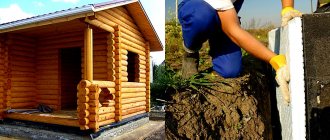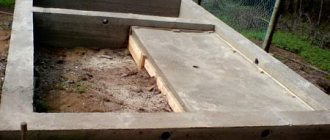Photo from banyaspec.com Going to the bathhouse is a useful weekly procedure for health, improves blood circulation in the body, relieves stress, strengthens weakened immunity and relaxes all muscles.
The broom is the main steam room, which plays an important role. It is made from various varieties of trees, bushes or meadow plants. These are the bath procedures that need to be done to nourish the body with phytoncides and beneficial substances.
Ask anyone whether it is worth steaming unprepared, most will answer, of course not. Everyone chooses what they like. You can, of course, buy a fragrant bouquet, but there is no guarantee that it is made using the right technology and will suit you.
In our article we will reveal the secrets of the health benefits of brooms, as well as proper preparation for the bath procedure.
The art of the Russian bath. Which broom to choose and how to steam it correctly?
Bath broom - why is it needed?
A broom is a mandatory attribute in a Russian bath. The tradition of its use goes back to the distant thousand-year history of the Slavic people. Today, many rules and rituals have been forgotten, so the question often arises about the true purpose of a bath broom.
The first mistake that is made about the role of a broom is using it as a tool that improves blood circulation through strong blows and whippings, until the steamer is completely exhausted. This view, first of all, repels many beginners from full immersion in the health-improving world of the bathhouse, since the impact of force is very unpleasant.
A natural bath broom is a conductor and concentrator of hot steam (air). In many bathing techniques it touches the body lightly or even not at all. There is another purpose - the release of essential oils. The third reason for using it is the fact that the broom can be used as a relaxation tool, massage, and relieving headaches.
What could be difficult about the technology for properly steaming a bath broom? He threw it into boiling water for five minutes, then pulled it out - splashed it on the stones and, most importantly, then whip it harder at the “victim”. In about the same way, every man in our country supposedly knows better exactly how to properly grill shish kebab. However, we will not deal further with cooking today, but we will give some recommendations on how to turn a Russian bathhouse from just a hot room with a high percentage of humidity into a real hospital.
Attribute Role
This is an elementary device, the tradition of using which passes from generation to generation with the constant addition of new and sometimes forgotten recipes for knitting and harvesting.
When using the bath attribute, you can simultaneously solve several tasks.
- Health improvement. The healing properties of trees of different species have a rejuvenating effect, activate metabolic processes and help open the pores of the skin. All this can be achieved if you know how to properly soak a bath broom.
- Massage treatments. It is necessary to bring the Russian steam room into a special cultural direction. These include various types of blows, from small stroking to hard and harsh whippings and injection of hot steam. Thanks to this, it is possible to achieve the transfer of useful substances, as well as microelements and vitamins, into the body by hot air. Essential oils released from steamed leaves and bark help improve tone and immunity.
- Intensification. The impact of high humidity and hot air on the body as a whole and on individual organs. Such combinations help achieve the best effect and serve to prevent a large number of diseases.
What types of bath brooms are there?
From time immemorial in Rus', various trees and shrubs were used as this integral attribute of the bathhouse - birch, oak, pine, spruce, fir, nettle and juniper, and in the southern regions - eucalyptus.
Brooms can be divided into 2 groups:
- fresh, which are collected 2-3 hours before bath procedures;
- dried, which should be prepared in summer or autumn. They are ideal for steaming all winter and spring, until it’s time to assemble a new set of brooms.
As for the materials themselves, branches of trees, shrubs and even grass are used here. The most popular are:
- oak: perfectly cleanses, suitable for oily skin, as it removes excess sebum and tightens pores;
- birch: the most common broom. The leaves generate steam well and perfectly absorb sweat, cleanse and tone the skin;
- lime: for people suffering from migraines. Helps cleanse blood vessels and relieve stress.
- Eucalyptus: has a wonderful aroma and is good for the respiratory tract.
- juniper - for careful use. Juniper is listed in the Red Book, so we do not recommend its use unless absolutely necessary. If you want to enjoy the pine aroma in the steam room, purchase pine steaming bags or essential oil.
Tips from a noble bathhouse attendant - how to steam a broom correctly.
Each collected broom has its own bouquet of useful properties, so they are chosen individually for yourself. We will tell you how to steam and soak different types of brooms. Let's start with two options for steaming a birch broom - one of the most affordable and popular.
To begin with, it is immediately worth noting that fresh brooms are not steamed. Just put it in warm water for 10-15 minutes and it’s ready, you can start steaming. Over a longer period of time they may become limp.
Option one, fast.
Experienced bath attendants recommend preparing two basins - with cold and warm water. The broom first needs to be rinsed a little, and then placed in cold water for a couple of minutes. Then it should be placed in a container with warm water for five minutes, and then poured into a ladle of boiling water and wrapped in a cloth bag or a towel “bag” for about 10 minutes. The point of the procedure is that the already delicate birch foliage and upper branches will receive a refreshing effect: they will straighten out, become much softer, acquire elasticity and a pleasant aroma.
Always ensure that the broom handle remains completely dry, above water, without getting wet.
Option two, advance, but very effective.
It is rare that people bring their own birch broom to visit the bathhouse. It is often dried and stored for a long, long time in order to be properly cooked. In this case, it is recommended to soak the broom for about 20 hours in cool water. Then, in the bathhouse, it is placed on the bottom shelf, having previously been wrapped in a damp towel.
Or, a dry broom can be kept in cold water in advance (several hours), and then wrapped in a wet towel overnight, then it will not fall off. When you unfold it, you will be surprised, but the broom will be almost fresh and natural. You can simply pour boiling water over it and start “working.”
If the choice fell on an oak broom, then its storage and steaming are somewhat different. The fact is that even dried oak leaves are much tougher and denser than birch leaves. The instructions include the following steps. To process, place the broom in boiling water for 15-20 minutes, and then briefly in cold water. Then put it back into boiling water for about three minutes - by this time, due to the temperature difference, the broom will reach the most comfortable and aromatic state - you can steam.
If you are short on time, then for quick processing you can use an emergency, but equally effective method of preparing a broom - you need to pour boiling water over it from all sides and place it on hot stones. That's enough. The steam will very quickly revive the leaves and make the branches soft - after two minutes you can safely go to the shelves and steam.
Another cunning method of steaming an oak broom is to pour boiling water into a bucket and place it like a “bouquet” so that the rods “look” down. The leaves will have more freedom - the broom will gain flexibility and fluffiness. These are the general rules for steaming in different ways.
Eucalyptus broom has a special aroma, for which it is especially valued. This plant does not require much for steaming - the broom can be placed in a bowl of hot water for about half an hour or less - it will retain all its beneficial properties, and if you sprinkle the “marinade” - water from the basin - for a few seconds when it hits the hot surface of the stones and the smell in the bathhouse will be simply divine. At the same time, the eucalyptus broom itself, as any bath expert will note, will have to be periodically collected a new one, because, unlike others, it quickly crumbles and cannot be used for a long time.
Separately, it is worth saying that the smell and healing properties of this plant have a beneficial effect, which is a sin not to use, so you should combine it - add a couple of small eucalyptus branches to a birch or oak broom. Try it - the result will definitely not disappoint you.
As for coniferous brooms, it is very important to use the brooms as fresh as possible - when the needles are elastic and not so prickly (for thrill-seekers, of course, there are no obstacles here). A coniferous broom is not as flexible as a deciduous one, so without pre-soaking it is dipped in boiling water for 20-30 minutes. Be sure to cover with a lid to preserve nutrients and essential oils.
The disadvantage of coniferous brooms may be the resin content, any amount of which quickly hardens and is difficult to wash off. Therefore, you don’t even have to steam with such a broom - just soak it in boiling water to fill the dacha bathhouse with a wonderful pine aroma. One such bathhouse on the weekend after the city, where there are exhaust fumes and dust, and for a couple of weeks you can forget about any cold.
Herbal broom. It is believed that it can only be used once because it is very soft. There is no need to soak it too much, just pour cold water over it and put it in boiling water for 3-5 minutes so that it absorbs moisture and gives off aroma. A pure herbal broom, without linden or other additives, can be used with any intensity. For example, at first actively, and then switch to a calmer pace.
Tip: to make your vacation as beneficial as possible, use bags with coniferous mixtures, not forgetting to add some fragrant herbs to them; in combination with deciduous brooms, they create an amazing effect!
Blank
Before enjoying bath procedures, you need to properly prepare your broom.
- You should stock up on twigs for production until June 20. To do this, you need to choose only dry weather, otherwise the raw leaves will gradually begin to darken during drying, and then curl and fall off. According to experts, the best time to cut out raw materials for a broom is in the morning, when the dew has already fallen. It is not recommended to perform the procedure in the evening.
- After cutting, the branches are folded and loosely tied, then hung to dry. To do this, you need to choose a place with a draft and no penetration of sunlight. After about a week, the rods are tightly collected and placed in a cool, damp place. The selected room must be well ventilated and dry.
- The blanks need to be laid out on the floor and turned over to the other side every day. As a result of such manipulations, the broom will take the shape of a fan.
- Next, the bundles are stacked one on top of the other. They should be stored in this form, periodically shifting them so that they do not cake. Gradually they will flatten and take on the required shape. It is important to ensure that the workpieces do not dry out too much.
- After drying, the branches should remain green and matte leaves with a strong aroma, which becomes even brighter when steamed. Therefore, it is important to know how to soak a bath broom correctly. It is recommended to store the bundles in a haystack to protect them from moisture.
What are herbal bath steams?
But not only brooms can give the bathhouse healing properties and be absorbed by the body through steamed skin. Special steamers in linen bags are very popular among professional bathhouse attendants. The action depends on their “filling”, changing which you can achieve a very different effect. Depending on the time of year, St. John's wort is added to such bags - essential oils have a good effect on gout or skin diseases, field mint - helps expand the respiratory tract, especially during colds, chamomile - also perfectly fights colds, horseradish and black currant (strengthens the immune system ).
In winter, it is very useful to steam bags of spruce, juniper, and fir needles. For problems with the digestive system, a bag of wormwood becomes useful, meadowsweet calms inflammatory processes, thyme protects against unnecessary nervousness, and sage reduces bleeding and heals wounds.
Many people call steaming for a bath the sister of a broom - to make the herbs work to their fullest, you need to dip the bag in hot (but not boiling water) for 30 minutes, and then pour the resulting infusion little by little over the heater and a little on the floor, obtaining aromatic and healthy steam. However, the stone should not be too hot - first, just pour boiling water on it, and then the tincture from the steaming - this way you will avoid direct burnt aromas, the herbs will reveal themselves in all their glory.
Questions and answers
If your home broom is very dry, how can you straighten the leaves?
Such branches must be immersed in hot water for one minute and then dried over stones for 30-40 seconds. If necessary, the procedure is repeated.
Can I use a frozen broom?
Can. To do this, first it is completely defrosted in a warm room, after which it is dipped in hot water and immediately taken out. After shaking slightly, the bunch is placed over the stones for 10 seconds. Now the frozen broom is ready to use.
Is it necessary to use a special teapot for processing brooms?
No. Any thick-walled basin or bucket is suitable for this. But steamers are better at maintaining the required water temperature.
What should you especially pay attention to when processing brooms?
The branches should not become limp and the leaves should not become excessively soft. Such connections become useless.
Is it possible to add additional essential oils to the water?
This should only be done when choosing tree brooms. When using bundles with plants, this should not be done so as not to provoke an allergic reaction.
Do not neglect the advice on how to properly brew a bath broom. This will allow you to get maximum pleasure during the procedure, and will also increase the service life of the bath attribute itself.
With health benefits - A noble bathhouse attendant on the secrets of steaming with a broom.
Notable bath attendants, who have been steaming for decades, shared their secrets and, as it is fashionable to say now, life hacks. Read:
- Use the water in which the broom, especially the herbal one, was brewed for washing and rinsing. This tones the skin, gets rid of dandruff, gives shine and silkiness to the hair;
- On your last visit to the steam room, place a broom under your lower back for 5-7 minutes. It will relieve pain and fatigue from muscles;
- Using leafy brooms, apply essential liquids/oils (5-10 drops per 200 ml of boiling water) to the stones: spruce, eucalyptus and other conifers. Use maximum healing properties;
- Between visits to the steam room, refresh your body with a cool shower. For internal balance, it is recommended to find water or kvass, sbiten, so that going to the bathhouse will benefit you. Do not drink alcoholic drinks under any circumstances.
Love the bathhouse, use brooms wisely. Purity of spirit, thoughts, and actions begins with purity of the body!
Your Noble Bath Attendant.
Steaming algorithm
1. Initially, you should inspect how the instrument is tied, and, if necessary, remove bare branches and add aromatic herbs. 2. Before steaming, be sure to wash the foliage with cold water. This is done in order to remove dust. 3. Soaking occurs in liquid at room temperature so that the foliage receives the required amount of moisture.
4. Saturation of wood fibers with liquid is carried out in the same way as in the previous case, namely, by immersing the bundle in a bucket of water like a bouquet, with the tips down. 5. Next, steaming is carried out by preparing a deciduous-wood infusion.
Most bath lovers use not only the remaining broth, but also cold water, after which they combine liquids to influence the temperature.











